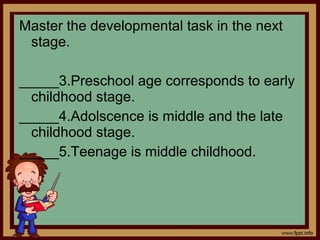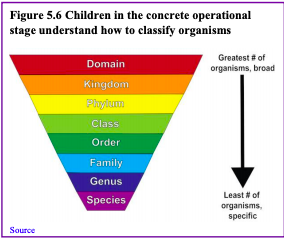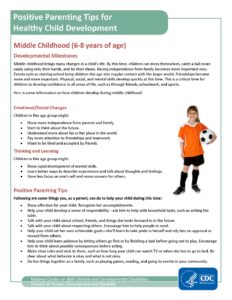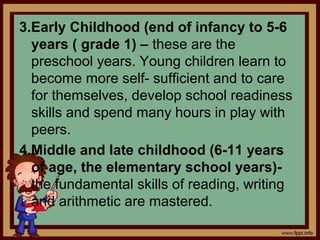During Middle and Late Childhood a Child Typically
Can do to help your child during this time. Children also seem to get thinner and gain more muscle strength.

Module 2 The Stages Of Development And Developmental Tasks
Later on in middle childhood approximately between ages 10 and 12 children begin to show a dawning appreciation of ideal reciprocity which is a method for determining what is fair based on an appreciation of equality between relationship partners and a desire to treat others well because ideally they would similarly want to treat you that well too.

. Angela Oswalt Morelli MSW edited by Mark Dombeck PhD. Children triple their strength capabilities during these years. During middle and late childhood achievement typically becomes an important theme of children.
The obvious physical changes are accompanied by changes in the brain. The large-scale body movement skills such as walking and running that they first learned during earlier developmental stages. Proportional changes are among the least pronounced in middle and late childhood.
An individuals attention span typically increases as he or she progresses from early childhood through middle and late childhood. During the period of development known as middle and late childhood a child typically does which of the following. C Children triple their strength capabilities during these years.
Children typically have more trouble focusing their attention and maintaining it during early childhood than they do. The brain continues to develop during late childhood. Children enter middle childhood still looking very young and end the stage on the cusp of adolescence.
At the beginning of this stage children follow basic. They have high self. In general boys develop these skills slightly faster than do girls except.
The developmental changes that occur in both linguistic and cognitive achievements as well as physical development over this period are dramatic. From age 6 to10 are the early school years when children establish their own identity. Middle And Late Childhood 6 12 Years Physical Development Ppt Video Online Download.
Roughly speaking the years of middle childhood are considered to be from 9 to 12 or 13 years. Children gain greater control over the movement of their bodies mastering many gross and fine motor skills that eluded the younger child. Children gain greater control over the movement of their bodies mastering many gross and fine motor skills that eluded the younger child.
While we dont see the actual brain changing we can see the effects of the brain changes in the way that. During the period of development known as early childhood a child typically does which of the following. Typically a child will gain 5-7 pounds a year and 2 inches per year.
B Children gain an average of 15 to 20 pounds per year during this period. As an age group 6- to 12-year-olds are less obviously set apart than infants adolescents and even preschool children are in most Western societies. Up to 24 cash back The child might feel uncomfortable or embarrassed around other people they dont know or certain activities and sports if they feel they are not good at them Intellectual development Most of the childs intellectual development takes place at school.
Elementary school children become more fatigued by running than by long periods of sitting. Begins to think more abstractly and logically d. Many childrens television shows and movies show animals and objects that can talk.
Boys are usually stronger than girls. Nevertheless the implicit grouping of ages 6-12 appears to be neither an idiosyncratic invention of Western cultures nor. Talk with her about her friends her accomplishments and what challenges she will face.
Learns to identify the letters of the alphabet. Middle childhood brings many changes in a childs life. By this time children can dress themselves catch a ball more easily using only their hands and tie their shoes.
The weight increase is due mainly to increases in the Which of the following statements is TRUE about motor development during middle and late childhood. Individuality and independence is first experienced by children during this phase of development. Having independence from family becomes more important now.
Masters the fundamental skills of writing. Middle and late childhood spans the ages between early childhood and adolescence approximately ages 6 to 11. Describe the patterns of physical growth Growth spurts occur during middle to late childhood.
Middle and late childhood spans the ages between early childhood and adolescence approximately ages 6 to 11. A Proportional changes are among the least pronounced in middle and late childhood. Gross Motor Skills Development.
Children gain an average of 15 to 20 pounds per year during this period. Healthy self-esteem is built on positive self-concept which gets pronounced during middle childhood years. During Middle and Late Childhood a Child Typically.
Most children have gone through a growth spurt that makes them look rather grown-up. Middle and late childhood spans the ages between early childhood and adolescence approximately ages 6 to 11 years. D Boys are usually stronger than girls.
Cognitive and linguistic progress on the surface is not as dramatic as physical and social development. Events such as starting school bring children this age into regular contact with the larger world. Girls usually outperform boys in gross motor skills.
Girls usually outperform boys in fine motor skills. What to typically expect as developmental milestone indicators from middle childhood 9-11 years of age. During middle childhood children continue to build on and improve gross motor skills.
Learns to identify letters of the alphabet c. Middle And Late Childhood Parenting And Family Diversity Issues. Self-esteem of middle childhood children is very high.
Children gain greater control over the movement of their bodies mastering many gross and fine motor skills that eluded the younger child. Children between the ages of 6 and 12 are in the age period commonly referred to as middle childhood. Spend time with your child.

Epingle Par Cindy Kalionzes Sur 18th Century Children Family Portrait Enfant Peintre Enfant

Chapter 17 Cognitive Development In Middle Childhood Human Behavior And The Social Environment I

Bright Futures At Georgetown University

Similarities Differences Between Childhood And Adulthood Compare And Contrast Similarities And Differences Childhood

Language Building Tips For Children Who Are Not Yet Speaking Parents As Teachers Teacher Info Language

Middle And Late Childhood Parenting And Family Diversity Issues

Pin By Sharon Champeau On Preschool Preschool Fine Motor Fine Motor Skills Development Motor Skills Activities

Characteristics Of Bilingualism In 2021 Middle School Writing Preschool Mom Middle School Science

Pin On Waldenu Pedsweek4assignment1 Resources

Phrase Or Clause Grammar Sort Middle School Activities Middle School Grammar Phrase

Speech Therapy Parent Handouts For Ei And Preschool Monthly Newsletters Speech And Language Preschool Speech Expressive Language

Development During Middle Childhood Youtube

Pin On Best Mom Board On Pinterest

Positive Parenting Tips For Middle Childhood 6 8 Prevent Child Abuse New Jersey

Module 2 The Stages Of Development And Developmental Tasks

Emotional And Social Development In Middle Childhood Lifespan Development

9 11 Years Ages And Stages Child Development Stages Family Day Care Child Care Development


Comments
Post a Comment